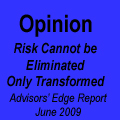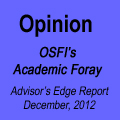I was asked on an old thread to comment on this issue in the light of the release of the split-share corporations first audited financials through Brompton’s dedicated web page.
| LBS Balance Sheet, 2006-12-31 (Simplified by James Hymas) |
| Assets |
(thousands) |
| Good Assets |
311,659 |
| Assets only an accountant could love |
14 |
| Total Assets |
311,673 |
| Liabilities |
|
| Misc. Liabilities |
3,010 |
| Preferred Shares |
120,000 |
| Total Liabilities |
123,010 |
| Shareholders’ Equity |
188,663 |
| Total Liabilities & Equity |
311,673 |
OK, so remember from the example of Sixty-Split that the Asset Coverage Ratio is defined as Total Money Available / Total Money Required.
Total Money Required is the redemption value of the preferreds: $120-million.
Total Money available is the Shareholders’ Equity plus the amount already earmarked for the prefs less the miscellaneous liabilities (because they get paid first or, at least, earlier) and also less the ephemeral assets of $14-thousand (because they will evaporate prior to the preferreds coming due AND because if the company gets wound up tomorrow there’s no actual cash to be gained from them), or $188,663 + $120,000 – $3,010 – $14 = $305,639.
Correction, posted 2007-4-11 : There is an error in the above. There is no need to subtract the $3,010 in miscellaneous liabilities because they were never added in the first place, since the positive figures being used come from the liability side of the balance sheet. Thus, the cash available is $188,663 + $120,000 – $14 = $308,649 and the coverage ratio is 2.57:1.
Another way to arrive at this number is consider the total money available to the company on liquidation, less the amounts that have to be paid out before the prefholders get paid: $311,659 – $3,010 = $308,649.
Which just goes to show, you have to be careful with this stuff and, if possible, check it with a different method!
Therefore, the Asset Coverage Ratio is $305,639 / $120,000 = 2.55:1.
Or, to put it in DBRS terms, there’s downside protection of 60.7% … in other words, the assets could lose 60.7% of their value and there would still be enough in the kitty to pay off the preferred shareholders (although the capital unit holders would lose their shirts).
Just how much asset protection one wants is a function, in part, of just what the assets are. If LBS held a portfolio of Junior Uranium explorers I would be more concerned, but I take the view that the LBS portfolio of big Canadian Banks and Insurers isn’t going to drop by that much any time soon. I’m happy with the coverage.
By way of comparison, the recent DBRS rating of CFS.PR.A as Pfd-1 started off the summary with:
The rating of the Preferred Shares is based on the following:
(1) The available downside protection, which is 57% to the principal amount of the outstanding Preferred Shares at closing.
….
A full analysis is more complicated than that, obviously, but it is clear that on an Asset-Coverage basis, LBS.PR.A has nothing to be ashamed of. So now let’s go to the income statement:
| LBS Income Statement (thousands) (Simplified by James Hymas) |
| Income |
|
| Dividends, Interest & Lending |
2,038 |
| Expenses |
|
| Fees |
(547) |
| Expenses |
(185) |
| Brokerage |
(66) |
| Total Costs |
(799) |
| Preferred Distributions |
(1,304) |
| Capital Unit Distributions |
(2,981) |
| Realized & Unrealized Capital Gains |
26,858 |
| Total Change In Net Assets |
23,813 |
It should be remembered that these figures are derived from operations for the period October 17 (commencement of operations) to December 31. We’re interested in ratios, not absolute numbers, so we’ll assume – for now, for the purposes of this analysis only – that this INITIAL PARTIAL period gives a good indication of what may be expected (in terms of ratios) for FUTURE COMPLETE periods.
An assumption. For now.
So: we want to find out the income coverage. Total income for the period is $2,038 [thousands throughout] and is of a nature that appears to be sustainable. We’ll cut the boys a little slack, and ignore the $66 transaction costs … they had to invest all their money in the period, their first since inception, and given that the corporation takes a passive stance towards the stock portfolio, it’s not very likely to recur to the same extent. At the end of the period, they held a total of just over six million shares, so their COMMISSSIONS paid amount to just over a penny a share, which is entirely reasonable.
We have no idea, from just these figures, whether their trading was done competently or not. It is entirely possible that these guys are the most reckless idiots in creation and overpaid for their stock big-time, to the amount of $1.00 per share. It is also possible that they’re the smartest, toughest negotiators & traders in the world and UNDERPAID for their stock, to the amount of $1.00 per share. This somewhat vital information, which may usually be relied upon to be a much greater number than piddly little commission expenses, is completely missing from such completely simplistic moronic idiocy as the Trading Expense Ratio, which, for instance, mutual funds are required to report by policy of the Canadian Securities Administrators, in an apparent effort to ensure that the gullible think they understand something.
But one way or another, we’ll exclude commission costs from the expenses, in the belief (hope?) that they were largely a one-time thing.
So to calculate income coverage, we come up with $2,038 – $547 – $185 = $1,306 presumably recurring net income after expenses, to cover preferred share distributions of $1,304.
Not quite an exact match, but close! We’ll say that income coverage is 100%, for purposes of this analysis. That’s pretty good! The figures shown in my article on split shares are even more out of date than they were when I wrote it, but serve as a reasonable benchmark. One Hundred Percent coverage implies that preferred shareholders may expect that there is a reasonable chance that they will get their dividends without the company having to dip into capital, thereby reducing the Asset Coverage Ratio.
All sorts of bad things could happen in the future, of course. What if the company is too generous in its distributions to the Capital Unit holders (there are limits to this under the prospectus; determining whether these limits are good enough is left as an exercise for the student)? What if all the banks cut their dividends to zero in response to taxation changes? You can never predict the future, but you can extrapolate the present … as long as you retain a healthy skepticism towards this and any other extrapolation (and watch the financials to ensure that you like what’s happening!), the income coverage on this issue looks quite good.
Not quite as good as DBRS noted for CFS.PR.A:
(3) The Interest Coverage Ratio test of 1.5 times for the Preferred Shares, which ensures a high level of protection to the holders of the Preferred Shares.
but good enough for investment grade.
DBRS rates this issue Pfd-2. There’s a chance I might quibble about this rating if I did a very thorough analysis of comparable issues and historical performances … but there’s nothing in these financials that makes me suspect that such a rating is completely out to lunch.
I’m happy with the rating. That does not imply anything at all about whether I think that LBS.PR.A is a good investment at this time at the current price.
Remember the Tech Wreck? Everybody and his shoe-shine boy was telling everybody else that ‘The Internet is going to change all our lives, and therefore Nortel is a fantastic buy at $110!’. Well, yeah. The internet is going to change our lives. And Nortel is a fine company (although perhaps I should have chosen another example, a company that can keep a set of books, for instance). BUT. BUT. BUT. That does not imply it should be bought irregardless of price.
First you determine value. Then you determine price. Then you subtract. Then you make an investment decision.
So, anyway, I’m not going to comment much on the investment characteristics of LBS.PR.A. I’m happy to rant and rave on and on about issues I consider lousy, but for discriminating between “Weak Sell”, “Hold”, “Buy” and “Strong Buy” (which aren’t actually terms I use, but serve as examples), you’ve got to be a client.
Or, soon (very soon!) a subscriber to PrefLetter!
But, out of the kindness of my heart, I’ve uploaded a recent evaluation of the HIMIPref™ Split-Share Index, to give interested readers a place to start.










































































































LBS.PR.A : Financial Statements & Some Comparatives
Thursday, April 5th, 2007I was asked on an old thread to comment on this issue in the light of the release of the split-share corporations first audited financials through Brompton’s dedicated web page.
OK, so remember from the example of Sixty-Split that the Asset Coverage Ratio is defined as Total Money Available / Total Money Required.
Total Money Required is the redemption value of the preferreds: $120-million.
Total Money available is the Shareholders’ Equity plus the amount already earmarked for the prefs less the miscellaneous liabilities (because they get paid first or, at least, earlier) and also less the ephemeral assets of $14-thousand (because they will evaporate prior to the preferreds coming due AND because if the company gets wound up tomorrow there’s no actual cash to be gained from them), or $188,663 + $120,000 – $3,010 – $14 = $305,639.
Correction, posted 2007-4-11 : There is an error in the above. There is no need to subtract the $3,010 in miscellaneous liabilities because they were never added in the first place, since the positive figures being used come from the liability side of the balance sheet. Thus, the cash available is $188,663 + $120,000 – $14 = $308,649 and the coverage ratio is 2.57:1.
Another way to arrive at this number is consider the total money available to the company on liquidation, less the amounts that have to be paid out before the prefholders get paid: $311,659 – $3,010 = $308,649.
Which just goes to show, you have to be careful with this stuff and, if possible, check it with a different method!
Therefore, the Asset Coverage Ratio is $305,639 / $120,000 = 2.55:1.
Or, to put it in DBRS terms, there’s downside protection of 60.7% … in other words, the assets could lose 60.7% of their value and there would still be enough in the kitty to pay off the preferred shareholders (although the capital unit holders would lose their shirts).
Just how much asset protection one wants is a function, in part, of just what the assets are. If LBS held a portfolio of Junior Uranium explorers I would be more concerned, but I take the view that the LBS portfolio of big Canadian Banks and Insurers isn’t going to drop by that much any time soon. I’m happy with the coverage.
By way of comparison, the recent DBRS rating of CFS.PR.A as Pfd-1 started off the summary with:
A full analysis is more complicated than that, obviously, but it is clear that on an Asset-Coverage basis, LBS.PR.A has nothing to be ashamed of. So now let’s go to the income statement:
It should be remembered that these figures are derived from operations for the period October 17 (commencement of operations) to December 31. We’re interested in ratios, not absolute numbers, so we’ll assume – for now, for the purposes of this analysis only – that this INITIAL PARTIAL period gives a good indication of what may be expected (in terms of ratios) for FUTURE COMPLETE periods.
An assumption. For now.
So: we want to find out the income coverage. Total income for the period is $2,038 [thousands throughout] and is of a nature that appears to be sustainable. We’ll cut the boys a little slack, and ignore the $66 transaction costs … they had to invest all their money in the period, their first since inception, and given that the corporation takes a passive stance towards the stock portfolio, it’s not very likely to recur to the same extent. At the end of the period, they held a total of just over six million shares, so their COMMISSSIONS paid amount to just over a penny a share, which is entirely reasonable.
We have no idea, from just these figures, whether their trading was done competently or not. It is entirely possible that these guys are the most reckless idiots in creation and overpaid for their stock big-time, to the amount of $1.00 per share. It is also possible that they’re the smartest, toughest negotiators & traders in the world and UNDERPAID for their stock, to the amount of $1.00 per share. This somewhat vital information, which may usually be relied upon to be a much greater number than piddly little commission expenses, is completely missing from such completely simplistic moronic idiocy as the Trading Expense Ratio, which, for instance, mutual funds are required to report by policy of the Canadian Securities Administrators, in an apparent effort to ensure that the gullible think they understand something.
But one way or another, we’ll exclude commission costs from the expenses, in the belief (hope?) that they were largely a one-time thing.
So to calculate income coverage, we come up with $2,038 – $547 – $185 = $1,306 presumably recurring net income after expenses, to cover preferred share distributions of $1,304.
Not quite an exact match, but close! We’ll say that income coverage is 100%, for purposes of this analysis. That’s pretty good! The figures shown in my article on split shares are even more out of date than they were when I wrote it, but serve as a reasonable benchmark. One Hundred Percent coverage implies that preferred shareholders may expect that there is a reasonable chance that they will get their dividends without the company having to dip into capital, thereby reducing the Asset Coverage Ratio.
All sorts of bad things could happen in the future, of course. What if the company is too generous in its distributions to the Capital Unit holders (there are limits to this under the prospectus; determining whether these limits are good enough is left as an exercise for the student)? What if all the banks cut their dividends to zero in response to taxation changes? You can never predict the future, but you can extrapolate the present … as long as you retain a healthy skepticism towards this and any other extrapolation (and watch the financials to ensure that you like what’s happening!), the income coverage on this issue looks quite good.
Not quite as good as DBRS noted for CFS.PR.A:
but good enough for investment grade.
DBRS rates this issue Pfd-2. There’s a chance I might quibble about this rating if I did a very thorough analysis of comparable issues and historical performances … but there’s nothing in these financials that makes me suspect that such a rating is completely out to lunch.
I’m happy with the rating. That does not imply anything at all about whether I think that LBS.PR.A is a good investment at this time at the current price.
Remember the Tech Wreck? Everybody and his shoe-shine boy was telling everybody else that ‘The Internet is going to change all our lives, and therefore Nortel is a fantastic buy at $110!’. Well, yeah. The internet is going to change our lives. And Nortel is a fine company (although perhaps I should have chosen another example, a company that can keep a set of books, for instance). BUT. BUT. BUT. That does not imply it should be bought irregardless of price.
First you determine value. Then you determine price. Then you subtract. Then you make an investment decision.
So, anyway, I’m not going to comment much on the investment characteristics of LBS.PR.A. I’m happy to rant and rave on and on about issues I consider lousy, but for discriminating between “Weak Sell”, “Hold”, “Buy” and “Strong Buy” (which aren’t actually terms I use, but serve as examples), you’ve got to be a client.
Or, soon (very soon!) a subscriber to PrefLetter!
But, out of the kindness of my heart, I’ve uploaded a recent evaluation of the HIMIPref™ Split-Share Index, to give interested readers a place to start.
Posted in Index Construction / Reporting, Issue Comments, Primers | 1 Comment »